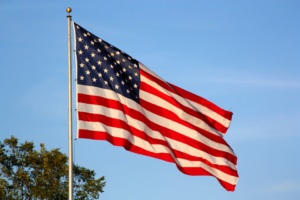Honoring Old Glory: Flag Protocol on National Flag Day
By Sharon Schweitzer
Annually, on June 14, the United States celebrates the Star Spangled Banner on National Flag Day. Celebrated on the anniversary of the Flag Resolution, signed by the Second Continental Congress in 1777, US citizens are called to hoist the stars and stripes with reverence and pride. This historic holiday was declared a national observance by President Woodrow Wilson on May 30, 1916, who declared that Flag Day is a time to “rededicate ourselves to the nation” and “stand with united hearts for our country.”
Our readers and followers have asked about the finer points of flag protocol, so we’re sharing some tips in time for Flag Day. Proper flag handling procedure is covered under federal law in Chapter 1, Title 4 of the United States Code. Our U.S. Supreme Court has ruled that displaying the U.S. flag is a protected right under the 1st Amendment; however, it is possible to be cited for improper use of the flag. The United States Flag Code stipulates that as the symbol of a living country, the flag is considered in itself a living thing and should therefore be properly cared for and displayed. To properly honor the flag, you want to be sure you’re displaying it correctly:
- Raise the flag briskly and lower it ceremoniously.
- Never allow the flag to touch the ground or floor.
- The flag should never be transported flat or horizontally, but always aloft
- Do not fly the flag in bad weather, unless you are 100% certain it is an all-weather flag.
- Fly the flag only from sunrise to sunset. It can only be flown at night if it is properly illuminated.
- The flag should always be allowed to fall free.
- The flag may not be used to carry, store, or deliver any items.
- Never fly the flag upside down except to signal an emergency.
- When displaying the flag indoors, accord the banner a place of honor, to the right of any displays, stages, or sanctuaries.
- When displaying the flag against a wall, the union stars should be at the top and to the observer’s left.
The U.S. American flag is displayed every day, and especially on the days listed below. We have indicated the dates to fly the flag at half-staff.
From now until the end of 2024, important dates to note are:
- May 5th, National Fallen Firefighters Memorial Service
- May 15th, Peace Officer’s Memorial Day
- May 27th, Memorial Day
- July 27th, Korean War Veterans Armistice Day
- September 11th, Patriot Day
- December 7th, Pearl Harbor Remembrance Day
These tips will help you raise the Star-Spangled Banner in style. Happy National Flag Day!
Photo by Pixabay
Sharon Schweitzer JD, is a diversity and inclusion consultant, cross-cultural trainer, etiquette expert, and the founder of Access to Culture. In addition to her accreditation in intercultural management from the HOFSTEDE Centre, she is an attorney and mediator. Sharon served as a Chinese Ceremonial Dining Etiquette Specialist in the documentary series Confucius was a Foodie, on Nat Geo People. Her Amazon #1 Best Selling book in International Business, Access to Asia: Your Multicultural Business Guide, won a coveted Kirkus Star, and was named to Kirkus Reviews’ Best Books. She’s a winner of numerous awards, including the British Airways International Trade Award at the Greater Austin Business Awards.
#SharonSchweitzer, #AccesstoCulture, Access2Culture, #InternationalCelebration, #AccesstoAsia, #GlobalEtiquette, #Cross-CulturalTrainer, #InterculturalCommunication, #InternationalCommunication, #Interculturalist, #Etiquette, #CultureExpert, #Speaker, #KeynoteSpeaker, #UnitedStates, #FlagProtocol, #NationalFlagDay


Leave A Comment